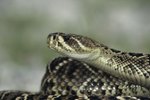
The nonvenomous California mountain kingsnake (Lampropeltis zonata) and the scarlet kingsnake (Lampropeltis elapsoides) are two species often confused for the deadly eastern coral snake (Micrurus fulvius). These three doppelgangers share similarly colored banding and habitats; fortunately, a handful of physical and behavioral characteristics set these serpents apart.
Coloring
All three species share variegated red, black and yellow banding. The easiest way to differentiate kingsnakes from coral snakes is by looking at their coloring: coral snakes have yellow and red bands that touch each other, while black bands always separate the yellow and red bands on kingsnakes. The well-known rhyme, “red touches yellow, kill a fellow; red touches black, friend of Jack” is used to differentiate coral snakes and lookalike kingsnakes.
Snout
Kingsnakes have elongated snouts that come to a rounded point. The scarlet kingsnake has a red snout while the California mountain kingsnake has either an all-black snout or a black-and-yellow snout. Coral snakes have shortened, very rounded, blunt snouts that are always black in color.
Toxicity
Coral snakes are members of the venomous Elapidae family, which includes cobras and mambas. A coral snake bite injects neurotoxic venom that causes slurred speech, double vision, muscle paralysis, respiratory and cardiac failure and eventual death if the victim doesn't get medical attention. Luckily, coral snakes rarely bite humans: the United States has not reported an eastern coral snake–related death since the 1960s. Kingsnakes are harmless, nonvenomous snakes popular as household pets.
Behavior
Both coral snakes and kingsnakes are largely diurnal and prefer to spend the daytime hours underground in caves and crevices and underneath logs and leaves. However, while coral snakes rarely climb shrubs or trees, kingsnakes are adept climbers. Coral snakes also display unique defensive behavior: they swing and move their tails to mimic their heads in an attempt to confuse predators. Kingsnakes do not display such defensive behavior. They are some of the “kings” of the serpent world, often killing and feeding on other larger venomous snakes like rattlesnakes and copperheads.
References
Resources
Photo Credits
-
Brent Stirton/Getty Images News/Getty Images
Writer Bio
Christina Stephens is a writer from Portland, Ore. whose main areas of focus are pets and animals, travel and literature. A veterinary assistant, she taught English in South Korea and holds a BA in English with cum laude honors from Portland State University.




